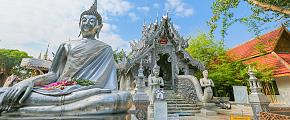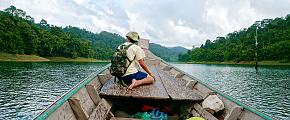Things to Know About Religious Culture in Thailand
Thailand is a truly fascinating country with a rich religious landscape that has deeply influenced its culture. From the awe-inspiring temples to the stunning festivals that take place throughout the year, Thailand's religious traditions are truly an integral part of the country's allure. While Buddhism is the dominant religion, Thailand is also home to a number of smaller religious communities that add to its unique cultural tapestry. By exploring the religious traditions of Thailand, visitors can gain a deeper understanding of the country's cultural heritage, therefore enhancing their overall experience of this amazing destination. Join us as we take a journey through the religions of Thailand and discover their impact on tourism in this captivating country.
 Monk and Temple in Tailand
Monk and Temple in Tailand
Brief History of Buddhism in Thailand
Introduced to Thailand in the 3rd century BCE by Indian missionaries, Buddhism has evolved into the dominant religion in Thailand. According to a census conducted in 2022, 92.6% of Thailand's population practice Buddhism. Throughout its history, Buddhism in Thailand has undergone many changes, adapting to the local culture while incorporating local beliefs and practices. Over time, Theravada Buddhism, a distinct branch of Buddhism, developed and thrived in Thailand, which is characterized by a strong emphasis on mindfulness, compassion, and the pursuit of enlightenment. If you visit Thailand today, you will surely be amazed by the many Buddhist temples and Buddha statues in the country.
Many of these sacred sites are among the most popular and sought-after destinations for tourists visiting Thailand and are sure to leave you in awe of their beauty and history. So why not read along to immerse yourself in Thailand's rich and fascinating religious traditions and explore its magnificent temples and Buddhist sites?
Thai Buddhist Temples and Architecture
Thai Buddhist temples, or "Wat", constitute an important part of the country's cultural heritage. There are over 40,000 Buddhist temples in Thailand, each with its own unique history and architecture. Often decorated with intricate carvings, these temples are a must-see for visitors to Thailand. Inside these temples, you will find a variety of religious and cultural artifacts, such as statues of the Buddha and paintings that depict scenes from the Buddha's life. Thai Buddhist temples are also important centers of education and community, with many Thai people visiting temples regularly to meditate, make offerings, and seek guidance from the monks.
There are many destinations where you can appreciate the beauty of Thai Buddhist temples, and Wat Phra Kaew of the Grand Palace in Bangkok is one of the best. It is a temple complex in the heart of Bangkok, and it is where Wat Phra Kaew is located. This temple, also known as the Temple of the Emerald Buddha, is one of the most sacred Buddhist sites in Thailand and houses the famous Emerald Buddha, a small statue of the Buddha made from green jadeite. In addition, the architecture of Wat Phra Kaew and the Grand Palace represents the epitome of traditional Thai design. You will be impressed by the intricate carvings and colorful decorations, which have endured hundreds of years of history.
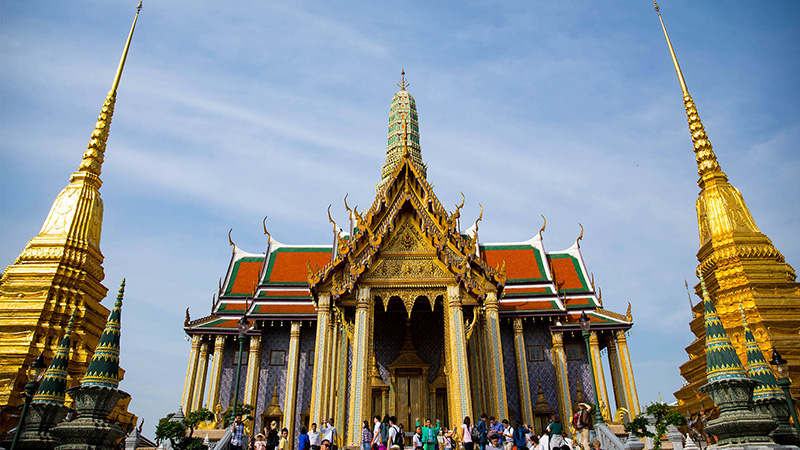 Wat Phra Kaew of the Grand Palace
Wat Phra Kaew of the Grand Palace
Ayutthaya is another great destination for Buddhist temples and architecture. As the former capital of Thailand, Ayutthaya is home to many extraordinary temples and ancient ruins and is now a UNESCO World Heritage Site for its cultural and historical significance. The two most famous temples in Ayutthaya are Wat Phra Si Sanphet and Wat Mahathat. The former was once a royal temple and is renowned for its three large Buddhist stupas; the latter is famous for the Buddha's head entwined in the roots of a tree, which is a popular photo opportunity for visitors. Beyond the two temples, there are also numerous ruins with intricate designs to explore in Ayutthaya.
Also worth visiting is Wat Pho in Bangkok. The highlight of Wat Pho is undoubtedly the giant statue of the Buddha in a reclining position, which is covered in gold leaf and measures over 150 feet long. The statue is an incredible sight to behold, which is why Wat Pho is also known as the Temple of the Reclining Buddha. But Wat Pho has much more to offer beyond the Reclining Buddha because there are many smaller temples, beautiful gardens, and courtyards around it, which are great examples of the ornate architecture and intricate designs that characterize Thailand's Buddhist artwork.
Buddhist Beliefs and Practices in Thailand
Woven into the fabric of Thai society, Buddhism is a deeply ingrained part of Thai people's daily life. One of the core beliefs of Buddhism is the Four Noble Truths. According to this belief, life is marked by suffering, but one can find a way to overcome it by following the Eightfold Path. This means letting go of desires and cravings, which are at the root of people's suffering. The Eightfold Path is a set of principles that guide practitioners toward the goal of liberation from suffering. It encompasses eight guidelines, including right understanding, right intention, right speech, etc. All of these are essential to achieving spiritual growth and peace. By embracing this path, one can cultivate a more compassionate way of life and learn to live in harmony with the world. Regarding Buddhist practices in Thailand they include daily offerings to the Buddha, chanting and meditation, and making merit (which is the practice of performing good deeds). These practices are not only performed by religious sites but are widely observed in Thailand, which reflect the prevalence of Buddhism in Thai people's everyday life. Additionally, it is common for young men to spend some time as a monk to gain merit and make merit for their families.
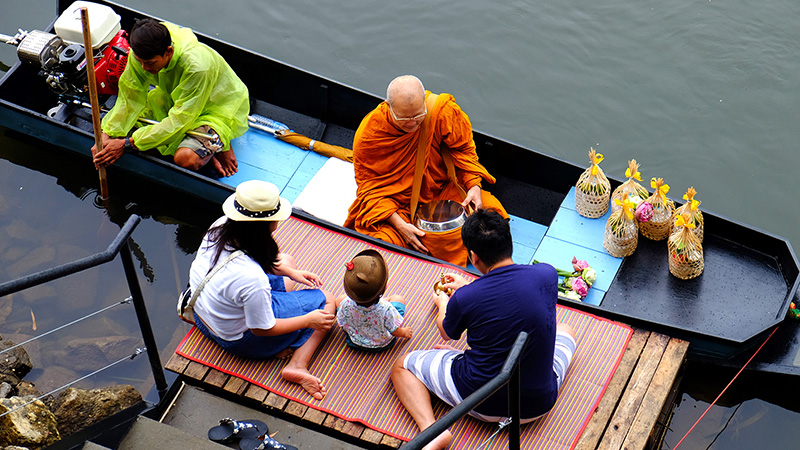 Thai Family Making Merit to a Monk
Thai Family Making Merit to a Monk
If you want to explore or even perform Buddhist beliefs and practices in Thailand, the most accessible way is to visit the Buddhist temples listed above. These beautiful temples will offer you a marvelous opportunity to witness Buddhist practices such as meditation and chanting. It should be noted that although most Thai temples are open daily from early morning until early evening, many people prefer to visit early at dawn when monks are performing their daily alms rounds and receiving offerings from the locals. This is also a quieter time of day when you can experience the peace and tranquility of the temple. While you are there, you can participate in the tradition of almsgiving by donating food or money to the monks. You can also choose to visit these temples during Buddhist festivals, which take place in Thailand throughout the year. Visiting a temple during one of these festivals can be a memorable experience, and we'll explore this topic in more depth later.
Apart from temples, Thailand is also home to many Buddhist retreat centers, where visitors can practice meditation to deepen their understanding of Buddhism. Some of the most popular meditation retreats include the International Dhamma Hermitage in Chiang Mai and the Wat Suan Mokkh International Dharma Hermitage in Surat Thani.
Buddhist Festivals and Holidays in Thailand
Many Buddhist festivals and holidays are celebrated in Thailand, which is a great chance to experience the spirituality of Thai culture. Among them, Songkran is considered the most popular Buddhist festival in Thailand. The name "Songkran" has its roots in the Sanskrit word "saṃkrānti", which means "astrological passage" or "transformation". Celebrated in mid-April, Songkran marks the traditional Thai New Year. According to Buddhist teachings, the act of pouring water on someone's hands or over a Buddha image is a way of washing away one's sins and bad luck, which is why the festival is known for its water-throwing tradition. People would splash each other with water on the streets and pour scented water on Buddha images during the Songkran festival. Also, they will engage in a variety of spiritual and communal activities, such as spending time with family, visiting temples, performing good deeds, and earning merit. Nowadays, Songkran is a joyful and colorful festival celebrated by people from all over the world who travel to Thailand for a fun-filled experience. Many cities will organize parades and other cultural events, and the streets will be lined with food stalls and vendors selling water guns and flowers.
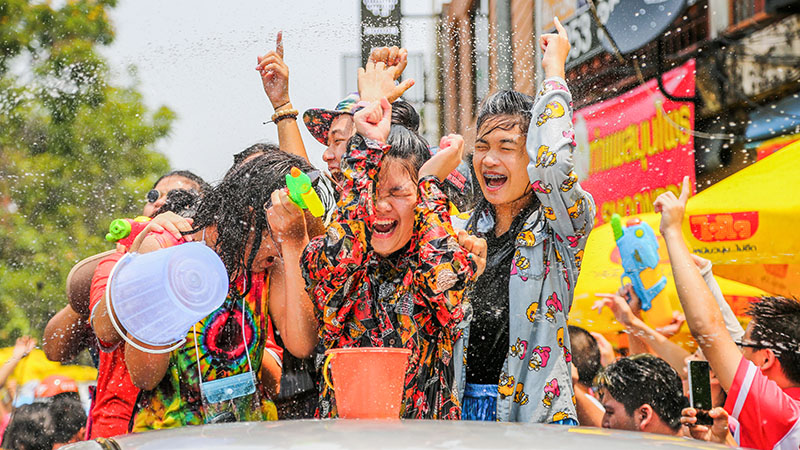 Songkran Festival
Songkran Festival
Following Songkran in April, Visakha Bucha Day is celebrated on the full moon of the sixth lunar month, which usually falls in May or June. As one of the most significant days in the Buddhist calendar, Visakha Bucha Day marks the birth, enlightenment, and death of the Buddha. Aside from visiting temples to offer prayers and make merit, many people would also light candles and incense to pay their respects to the Buddha. Just like Songrakn, Visakha Bucha Day is a public holiday in Thailand, with many businesses and schools closed for the day to take part in the festivities.
Asalha Puja Day is observed in July, which marks the day when the Buddha gave his first sermon to his disciples. As such, people would listen to sermons in sermons and make offerings. Monks often give teachings on the Four Noble Truths and the Eightfold Path, and there may be candlelit processions around the temple grounds. After Asalha Puja Day, Khao Phansa is celebrated in July or August. It marks the beginning of the Buddhist Lent or rainy season retreat. It is a period of time, which usually lasts for three months when monks are expected to stay in their temples and devote themselves to meditation and study. Many people use this time to make merit and perform acts of kindness, such as donating food and other necessities to the temple.
Known as the Festival of Light, Loy Krathong is a traditional Buddhist festival in Thailand that takes place in November. The festival is believed to have originated in ancient times as a way for people to give thanks to the goddess of water, Phra Mae Khongkha, for providing water for their crops and livelihoods. Today's Loy Krathong is characterized by the floating of small boats made from banana leaves, called Krathongs, on rivers and lakes. Of course, the festival is also a time for family gatherings and making merit, and people often visit temples to offer prayers and make donations.
Other Religions in Thailand
It's sometimes easy to overlook the existence of other religions in Thailand. As a matter of fact, there are also small communities of Muslims, Christians, and Hindus in Thailand. These communities have made significant contributions to the diversity and vitality of Thai culture and society.
As the second-largest religion in Thailand, Islam is mostly practiced in the southern provinces of Thailand. Among the many mosques in Thai, the most iconic one is the Chao Mae To Mo Mosque in Pattani. In terms of ethnic groups and cultural practices, The Muslim population in Thailand is diverse.
Christianity also has a long history in Thailand, and while it is a minority religion, it has left its mark with landmarks such as the Assumption Cathedral in Bangkok and the Holy Rosary Church in Nakhon Pathom. Hinduism and Sikhism have smaller followings but are still practiced, with the Sri Maha Mariamman Temple and Gurudwara Siri Guru Singh Sabha being the most famous temples in Bangkok.
Thailand's religious landscape is a fascinating aspect of the country's culture, with Buddhism being the dominant religion. Thailand's temples and religious festivals are some of the most spectacular in the world, attracting visitors from all over the globe. While Buddhism is the primary focus, Thailand also embraces several other religions, which have added to the country's cultural and religious diversity. By being immersed in the religious practices of Thailand, visitors can gain a deeper understanding of the country's culture, heritage, and people. If the idea of traveling to Thailand intrigues you, feel free to contact us for more travel information! Our dedicated team of travel specialists will respond to your questions and can provide you with a customized itinerary within 24 hours. Let us help you uncover the magic of Thailand - contact us now to create your personalized travel itinerary.

